b5u1基础知识回顾一电子教案
人教版英语学案《B5 U1-1 Reading》
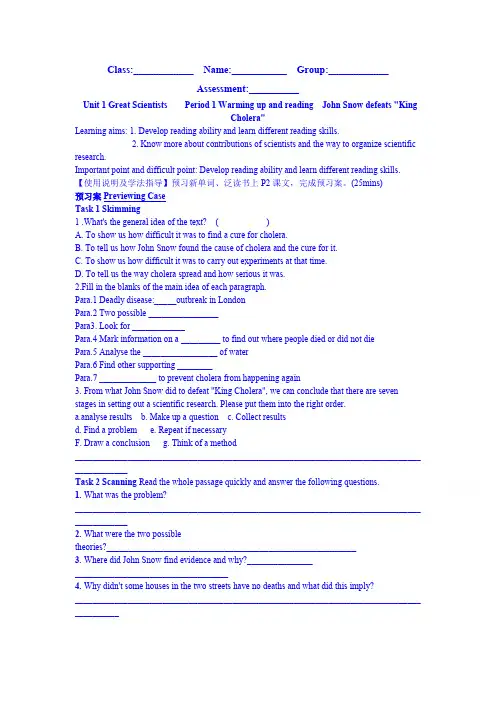
Class:____________ Name:___________ Group:____________Assessment:__________Unit 1 Great Scientists Period 1 Warming up and reading John Snow defeats "KingCholera"Learning aims: 1. Develop reading ability and learn different reading skills.2. Know more about contributions of scientists and the way to organize scientific research.Important point and difficult point: Develop reading ability and learn different reading skills. 【使用说明及学法指导】预习新单词、泛读书上P2课文,完成预习案。
(25mins)预习案Previewing CaseTask 1 Skimming1 .What's the general idea of the text? ( )A. To show us how difficult it was to find a cure for cholera.B. To tell us how John Snow found the cause of cholera and the cure for it.C. To show us how difficult it was to carry out experiments at that time.D. To tell us the way cholera spread and how serious it was.2.Fill in the blanks of the main idea of each paragraph.Para.1 Deadly disease:_____outbreak in LondonPara.2 Two possible ________________Para3. Look for ____________Para.4 Mark information on a _________ to find out where people died or did not diePara.5 Analyse the _________________ of waterPara.6 Find other supporting ________Para.7 _____________ to prevent cholera from happening again3.From what John Snow did to defeat "King Cholera", we can conclude that there are seven stages in setting out a scientific research. Please put them into the right order.a.analyse resultsb. Make up a questionc. Collect resultsd. Find a probleme. Repeat if necessaryF. Draw a conclusion g. Think of a method_______________________________________________________________________________ ____________Task 2 Scanning Read the whole passage quickly and answer the following questions.1.What was the problem?_______________________________________________________________________________ ____________2.What were the two possibletheories?_________________________________________________________3.Where did John Snow find evidence and why?__________________________________________________4.Why didn't some houses in the two streets have no deaths and what did this imply?_______________________________________________________________________________ __________5.What was wrong with the source ofwater?____________________________________________________6.What extra evidence did he find?_______________________________________________________________________________ _________7.What conclusion did he draw withcertainty?_________________________________________________Task 3 Careful reading (true or false)1.Cholera would never be controlled even if its cause was found.2.The disease attacked the body quickly from the stomach and soon the affected person died.3.John Snow began to collect the information before he disease spread.4.In two particular streets, 500 people died in 10 days when another outbreak hit London in 1854.探究案Exploring Case探究一Choose the best answer.1) What inspired john snow according to the first paragraph?__________A.Being queen victoria's personal physician. B.Finding where cholera happened. C.Helping ordinary people who suffered from cholera. D.Wanting to face the challenge 2) what is the use of john snow's map in his research?________________A.To help him find the number of dead people B.To help him not lose his wayC.To help him find the reason of the cholera outbreak D.To help him find the place where cholera happened3) which of the following is true according to the text?___________A.John became famous after cholera hit England in the 19th century.B.John began to collect information long before cholera hit England in the 19th century. C.The mother and her daughter mentioned in the text both lived n broad street.D.John felt unsure about the cause of cholera after he finished the map.4) Why was cholera xalled "king choelera" in the text?__________A.Because cholera caused many deaths.B.Because it got its name from queen Victoria.C.Cholera was the most deadly disease of its day.D.It was defeated with help of the king.5) another title of the text might be_________A.John and cholera B.The discovery of choleraC.John snow: a great scientist D.The achievement of john snow探究二Sentence focus Translate the following sentences into Chinese.1.John snow was a famous doctor in London-so expert, indeed, that he attended queen Victoria as her personal physician._______________________________________________________________________________ ____2.He immediately told the astonished people in bread street to remove the handle from the pump so that it could not be used._______________________________________________________________________________ __3.The water companies were instructed not to expose people to polluted water any more_______________________________________________________________________________ _______探究三Summary. Summarize the text in 30 words._______________________________________________________________________________ _______________________________________________________________________________ _______________________________________________________________________________ _______________________________________________________________________________ ________________________________________________训练案Exercise语法填空John was a well-known doctor in London in the 19th century. He wanted to find the cause of cholera in order to help people 1._________(expose) to cholera. He believed that people became ill 2._________________eating infected food. He used 3._+next outbreak of cholera to test4.____________________ideal. He marked on a map5.________________ all the dead people6.__________________(live) and he found that many people who had drunk the dirty water from the pump died. So he decided that this was7._____________the water in the pump was infected. He suggested water be found. Finally, "king cholera"10._____________(defeat).。
人教版高二英语B5U1教案(带反思)
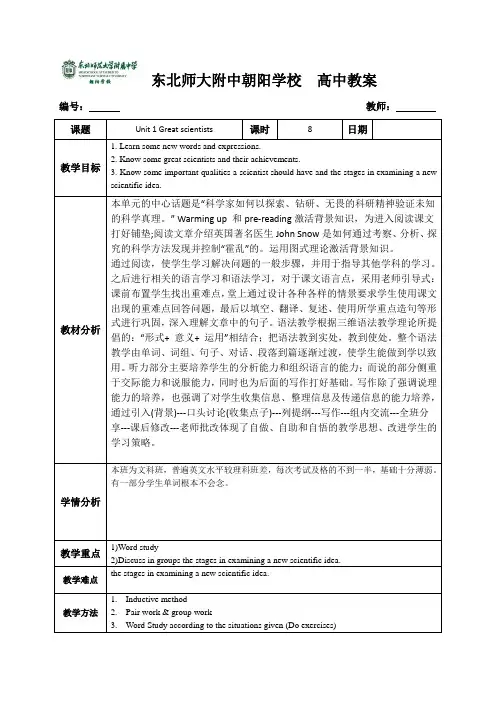
东北师大附中朝阳学校高中教案编号:教师:课题Unit 1 Great scientists 课时8 日期教学目标1. Learn some new words and expressions.2. Know some great scientists and their achievements.3. Know some important qualities a scientist should have and the stages in examining a new scientific idea.教材分析本单元的中心话题是“科学家如何以探索、钻研、无畏的科研精神验证未知的科学真理。
” Warming up 和pre-reading激活背景知识,为进入阅读课文打好铺垫;阅读文章介绍英国著名医生John Snow是如何通过考察、分析、探究的科学方法发现并控制“霍乱”的。
运用图式理论激活背景知识。
通过阅读,使学生学习解决问题的一般步骤,并用于指导其他学科的学习。
之后进行相关的语言学习和语法学习,对于课文语言点,采用老师引导式:课前布置学生找出重难点,堂上通过设计各种各样的情景要求学生使用课文出现的重难点回答问题,最后以填空、翻译、复述、使用所学重点造句等形式进行巩固,深入理解文章中的句子。
语法教学根据三维语法教学理论所提倡的:“形式+ 意义+ 运用”相结合;把语法教到实处,教到使处。
整个语法教学由单词、词组、句子、对话、段落到篇逐渐过渡,使学生能做到学以致用。
听力部分主要培养学生的分析能力和组织语言的能力;而说的部分侧重于交际能力和说服能力,同时也为后面的写作打好基础。
写作除了强调说理能力的培养,也强调了对学生收集信息、整理信息及传递信息的能力培养,通过引入(背景)---口头讨论(收集点子)---列提纲---写作---组内交流---全班分享---课后修改---老师批改体现了自做、自助和自悟的教学思想、改进学生的学习策略。
B5U1导学案
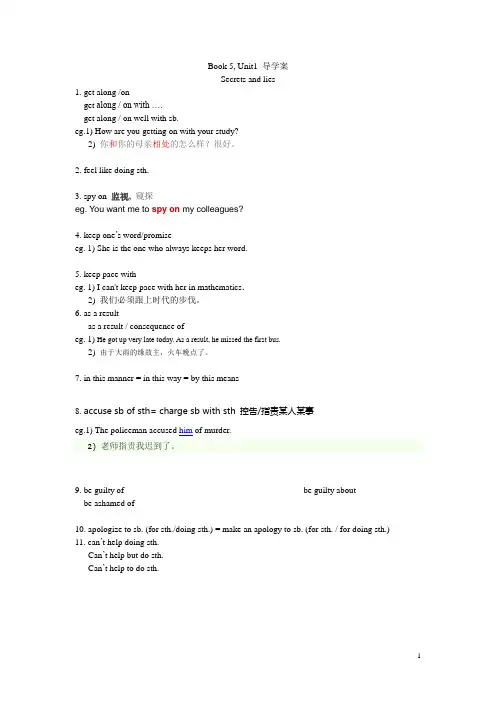
Book 5, Unit1 导学案Secrets and lies1. get along /on _______________ _____________get along / on with …. _______________________ ________________________get along / on well with sb. ____________________eg.1) How are you getting on with your study?2) 你和你的母亲相处的怎么样?很好。
2. feel like doing sth. ___________________3. spy on 监视, 窥探eg. You want me to spy on my colleagues?4. keep one’s word/promise ___________________eg. 1) She is the one who always keeps her word.5. keep pace with ______________________eg. 1) I can't keep pace with her in mathematics.2) 我们必须跟上时代的步伐。
6. as a result _______________________as a result / consequence of ___________________eg. 1) He got up very late today. As a result, he missed the first bus.2) 由于大雨的缘故主,火车晚点了。
7. in this manner = in this way = by this means ______________________8. accuse sb of sth= charge sb with sth 控告/指责某人某事9. be guilty of ___________________ ___________________ be guilty about _____________ be ashamed of _______________10. apologize to sb. (for sth./doing sth.) = make an apology to sb. (for sth. / for doing sth.)11. can’t help doing sth. _____________________Can’t help but do sth. ____________________Can’t help to do sth. _______________________Book 5 Unit1 Page5-191. be gifted/ talented at (in) = have a gift/talent for ________________________eg 1) He is gifted / talented at football.2) He has a gift /talent for playing piano.2. before long = soon ________________________long before ____________________eg 1) Before long he got married.2) She had left long before.3. persuade sb. to do sth.= persuade sb.into doing sth. ____________________________eg. How can I persuade this child to help me?= How can I persuade this child into helping me?4. rather than ___________________would rather do sth. than __________ = prefer to do sth. rather than __________. = prefer doing sth. to ____________. 宁愿做某事而不愿做某事。
B5U1 知识讲练课1
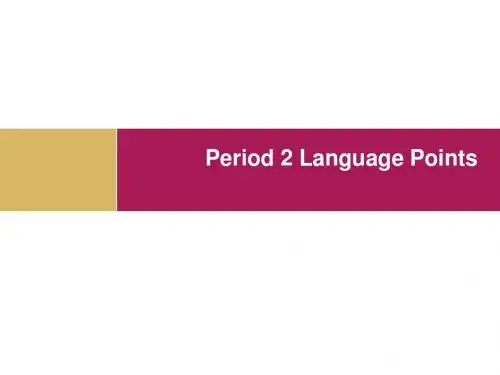
-18-
-13-
-14-
Practice and Presentation
训练目的:灵活运用所学知识点,学会运用实际操练的方法感悟 语言知识并在运用中体验英语表达之美。
Content Demands
Finish Challenge I and II
1 Put what we have learned into use and try to analyze the exercise carefully
in addition to 除……之外(还有,包括在内)
besides 除……之外(还有,包括在内) except (for)除……之外除……之外(还有,不包括在内) except that 除了…除……之外(还有,不包括在内) [练习]选短语填空。
(1) besides/ in addition to/apart from (2) except for
For groups: 抓住自学,讨论,展示,点评环节 争创“优秀小组” For members: 认真落实各项任务
-4-
Self-directed study
Content
Learn the important words and their usages in this unit.
DemandsLeabharlann fans will attend his lecture this evening.
4. expose vt. (1)使暴露,显露 (2)曝光 (3)揭露 exposure n. (在日光 、风雨、危险中)暴露,暴晒(后接
+to+n.);(摄影的)曝光
be exposed to ….置身于……;暴露于…
B5M10U1教学设计
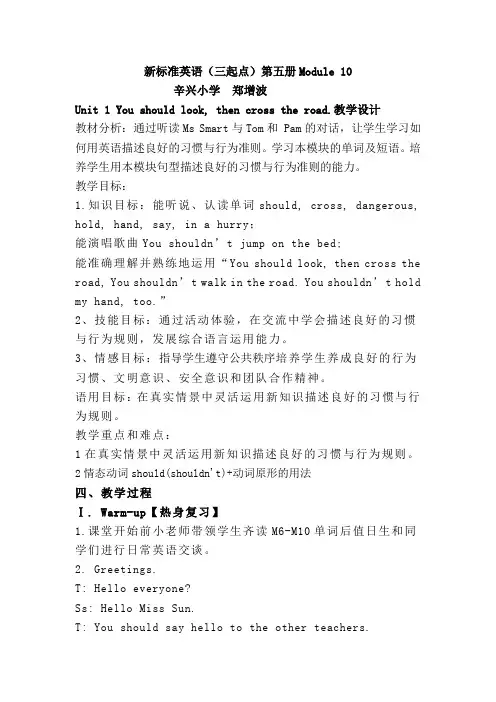
新标准英语(三起点)第五册Module 10辛兴小学郑增波Unit 1 You should look, then cross the road.教学设计教材分析:通过听读Ms Smart与Tom和 Pam的对话,让学生学习如何用英语描述良好的习惯与行为准则。
学习本模块的单词及短语。
培养学生用本模块句型描述良好的习惯与行为准则的能力。
教学目标:1.知识目标:能听说、认读单词should, cross, dangerous, hold, hand, say, in a hurry;能演唱歌曲You shouldn’t jump on the bed;能准确理解并熟练地运用“You should look, then cross the road, You shouldn’t walk in the road. You shouldn’t hold my hand, too.”2、技能目标:通过活动体验,在交流中学会描述良好的习惯与行为规则,发展综合语言运用能力。
3、情感目标:指导学生遵守公共秩序培养学生养成良好的行为习惯、文明意识、安全意识和团队合作精神。
语用目标:在真实情景中灵活运用新知识描述良好的习惯与行为规则。
教学重点和难点:1在真实情景中灵活运用新知识描述良好的习惯与行为规则。
2情态动词should(shouldn't)+动词原形的用法四、教学过程Ⅰ. Warm-up【热身复习】1.课堂开始前小老师带领学生齐读M6-M10单词后值日生和同学们进行日常英语交谈。
2. Greetings.T: Hello everyone?Ss: Hello Miss Sun.T: You should say hello to the other teachers.Ss: Hello.3. Let’s rap.一起说唱课本41页活动4的rap.T: 指着部分同学说:“You should say loudly.”“You should point. You should listen carefully. 同时板书should4T:(出示大屏幕)Look! The girl is crossing the road. What should she do? Ss: She should look, then cross the road.T: Yes, you should look, then cross the road。
Module5Unit1教案-外研版八年级上册英语
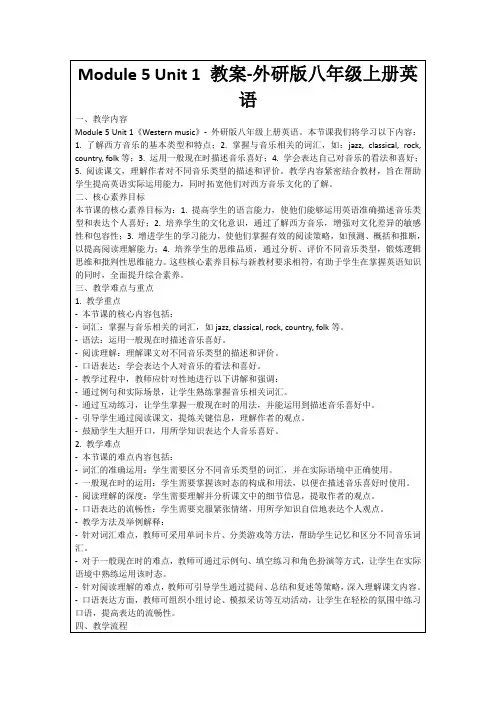
一、教学内容
Module 5 Unit 1《Western music》-外研版八年级上册英语。本节课我们将学习以下内容:1.了解西方音乐的基本类型和特点;2.掌握与音乐相关的词汇,如:jazz, classical, rock, country, folk等;3.运用一般现在时描述音乐喜好;4.学会表达自己对音乐的看法和喜好;5.阅读课文,理解作者对不同音乐类型的描述和评价。教学内容紧密结合教材,旨在帮助学生提高英语实际运用能力,同时拓宽他们对西方音乐文化的了解。
3.成果分享:每个小组将选择一名代表来分享他们的讨论成果。
(五)总结回顾(用时5分钟)
今天的学习,我们了解了西方音乐的基本概念、类型和表达个人喜好的方法。同时,通过实践活动和小组讨论加深了对音乐文化的理解。我希望大家能够掌握这些知识点,并在日常生活中灵活运用。最后,如果有任何疑问或不明白的地方,请随时向我提问。
-对于一般现在时的难点,教师可通过示例句、填空练习和角色扮演等方式,让学生在实际语境中熟练运用该时态。
-针对阅读理解的难点,教师可引导学生通过提问、总结和复述等策略,深入理解课文内容。
-口语表达方面,教师可组织小组讨论、模拟采访等互动活动,让学生在轻松的氛围中练习口语,提高表达的流畅性。
四、教学流程
三、教学难点与重点
1.教学重点
-本节课的核心内容包括:
-词汇:掌握与音乐相关的词汇,如jazz, classical, rock, country, folk等。
-语法:运用一般现在时描述音乐喜好。
-阅读理解:理解课文对不同音乐类型的描述和评价。
-口语表达:学会表达个人对音乐的看法和喜好。
-教学过程中,教师应针对性地进行以下讲解和强调:
B5U1基础梳理
Book 5 Unit1知识梳理构建案【Learning aims】1.Grasp the important words and phrases and sentence patterns in this unit.2. Learn the method of constructing knowledge tree by analyzing the sentences.【Key and difficult points】①Revising the important phrases; ②blame, contribute, absorb, conclude, expose, attendI.重点词汇1. blame vt. 责备, 指责; 把…归咎于…; n. 过失, 责备1) The children were to blame for breaking the glass. 孩子们打破了玻璃应受责备。
2) It seems that the water is to blame. = The water seems to blame. 似乎水是罪魁祸首。
【拓展】blame sth. on sb. 将某事归咎于某人blame sb. for sth./doing sth. 因为某事责备某人be to blame (for)… 应(为…)承担责任/受责备(此处不能用被动语态)2. contribute v.捐献, 捐助;贡献;contribution n.贡献;捐献;投稿contributor n. 投稿者;捐助者1) Have you contributed any money to that church? (donate) 你有没有给那个教堂捐一些钱?2) Eating too much can contribute to heart diseases and cause high blood pressure. (lead to)【拓展】make a contribution to = make contributions to = contribute to 对…作出贡献,有利于,导致3. absorb vt.吸收;汲取,理解(知识等);使全神贯注;吸引(注意等)1) Black cloth absorbs light. 黑布吸收光线。
B5 M1(1)
B5 Module 1 British and American English【学习目标】1.Introduction 2. Key words and expressions of this module【学习重点和难点】Words and expressions: differ, remark, omit, variety, compare, confuse, queue, have difficulty (in) doing sth get around have…in common with…lead to (doing) sth【学习策略指导】借助多媒体引导学生自主学习,合作探究【预习自学】预习相关单词并在课文中标出【教学环节设计】Step 1 IntroductionStep 2 Words and Expressions1.have …in common with 和…有相同之处I have a lot in common with my deskmate.Their opinions have little / much / nothing in common with mine.拓展:in common with 与……一样In common with many young people, he also likes pop songs.2.make a / some / much / all the / no difference (to sb/sth)1) 对(某人/ 事)有/有些/有大的/重大的/没有影响2) 对(某人/ 某事)重要或不重要Flowers make no / a lot of / some / difference to a room.It doesn’t make any difference to me whether you go or stay.3.get around 1) 四处走动(旅行) 2)(消息)传开3) 回避;逃避Mary’s father really gets around: Monday he was in Washington; Wednesday he was in Chicago; and today he is in New Y ork.Bad news gets around quickly.Some people try to get around the tax.4. queue n. 行列, 长队, 队列vi. 排队, 排队等待By 7 o’clock the queue had formed outside the cinema.We queued for an hour but didn’t get in.拓展:form a queue排成一队queue up at the box office在售票处排队jump the queue插队;加塞5.confusing adj. 令人困惑的;难懂的(所修饰的对象一般为物)Foreign press reports are rather confusing. 外国新闻报道十分混淆视听。
B5 U1 A-
Unit One What’s he like?【单元学习内容】本单元重点学习描述任务体形特征的英语表达,表示体形特征的单词tall, short学生已经比较熟悉,本单元新增添了old ,yong ,funny,, strict,等性格特征的单词。
本单元重点学习询问别人形体特征的问句:What’s …like?及相应的答句He’s… She’s….【单元学习目标】(一)能力目标:1. 能够简单描述自己教师的体貌特征及性格特点,如:We have a new English teacher. He’s tall and strong. He’s very funny.(She’s kind).2. 能够询问并介绍学校里教师的情况,如:Who’s your English teacher? Mr Carter .He’s from Canada. What’s he like? He’s tall and strong.3. 能够听懂一些描述人物特征的简单对话,完成学生用书中的Let’s try 部分。
4. 能够听懂、会唱歌曲“My New Teacher”.能够灵活替换歌词中的科目及表示人物特征的形容词。
(二)知识目标:1. 能够掌握A、B两部分Let’s learn和Read and write中的四会单词。
2.能够听、说、认读A、B部分Let’s talk中的单词和句型。
3.能够掌握A、B部分Read and write中的四会句型,并能灵活运用。
4. 能够了解字母组合bl,br的发音规律并能读出例词。
5. 了解Story time,Good to know等部分的内容。
(三)情感.策略.文化意识等目标:1. 情感态度:根据小学高年级阶段学生的特点,引导他们在英语学习过程中更大限度发挥自主学习能力,积极主动地进行英语学习,更好地激发他们英语学习的兴趣。
2. 学习策略:学习过程中注意培养学生合作学习的态度和方法,有效利用学生用书中设计的Pair work 、Group work、Talk and draw 以及Task time部分,培养学生合作学习的意识。
B5M1-3教案
BOOK5 Modules1-3 复习课教案【课程目标】语言技能目标:语言技能目标(六级)听:3.能听懂故事或记叙文,理解其中主要人物和事件以及他们之间的关系;4.能从听力材料,简单演讲或讨论中提取信息和观点。
说:1.能传递信息并就熟悉的话题表达看法;5.能用英语进行简单的语言实践活动,如访谈;读:1.能从一般文字资料中获取主要信息;4.能根据阅读目的不同,使用不同的阅读策略;5.能通过不同信息渠道查找所需要信息。
写:2.能简单地描述人物或事件,并简单地表达自己的意见。
语言知识目标:语言知识目标(七级)语音:2.根据语音、语调了解话语中隐含的意图和态度;词汇:1.理解话语中词汇表达的不同功能、意图和态度等;语法:1.掌握描述时间、地点和方位的常用表达方式。
情感态度目标:情感态度目标(七级—八级)6.在学习中有较强的合作精神,愿意与他人分享各种学习资源;学习策略目标:学习策略目标(七级)交际策略:.利用各种机会用英语进行真实交际;资源策略:通过图书馆、计算机网络、广播和电视等资源获得更广泛的英语信息,扩展所学知识。
文化意识目标:文化意识目标(七级—八级)通过学习英语了解世界文化,培养世界意识。
【学习目标】①知识目标:通过扎实掌握词汇和短语及其用法。
找出重点和难点,从而达到活学活用的知识目标目的。
如take .. for granted;refer to.. as;offer to do sth;require等的用法。
②能力目标:提高学生听、说、读、写综合运用语言的能力及分析问题、解决问题的能力。
③情感目标:培养学生稳定和持久的英语学习动机。
【导学学案使用说明】1)学生先自主合作学15分钟,了解重要词汇及短语的用法。
2)用红笔画出重点和难点。
【学习过程】Step1:课前检测(用时5分钟)快速自我检测见单页.Step2:板书并解释学习目标,明确要求。
A级:扎实掌握词汇和短语及其用法。
B级:灵活运用本模块的知识。
- 1、下载文档前请自行甄别文档内容的完整性,平台不提供额外的编辑、内容补充、找答案等附加服务。
- 2、"仅部分预览"的文档,不可在线预览部分如存在完整性等问题,可反馈申请退款(可完整预览的文档不适用该条件!)。
- 3、如文档侵犯您的权益,请联系客服反馈,我们会尽快为您处理(人工客服工作时间:9:00-18:30)。
Unit 1 Great Scientists 基础知识回顾(一)I.重点词汇1.n特征;特性____________2.n挑战____________3. n专家;行家;adj熟练的;经验知识丰富的____________4.v分析____________5. v照顾;护理;出席;参加____________6. n 治愈;v治疗____________7. n受害者____________8. v吸收;吸引;使专心____________9. v 怀疑____________10. adj严重的;剧烈的;严厉的____________adv__________ 11. v预见;预知____________ (过去式)____________ (过去分词)____________12. v污染____________ n污染;污染物____________13. v责备;谴责;n过失;责备__________ 14.v处理;操纵;n 把手____________ 15.v宣布;通告____________ 16.v建设;修建____________ n建设;建筑物____________17. v捐献;贡献;捐助____________ n____________ 18v打败;战胜;使受挫折;n失败____________ 19. 科学的____________20. 除...之外;此外____________ 21. 使...显露;暴露____________ 22. 得出结论_____________23.提出______________ 24.应受到责备______________ 25. 专心于...;专注于...______________II. 根据句意和单词首字母或括号内汉语,写出单词的正确形式。
1. What are the________ (特征,特性) of the medicine?2. The scientists are doing s________ research on the rats.3. Examine the results carefully, and you will make a c________.4. He was ________(被战胜)at chess last night.5. The babies are well a________ to in the nursery.6. It's very dangerous to be e________ to SARS patients without any protection.7. The teacher_______ (宣布) that we would have a few days off.8. Who is to b________ for the accident?9. He found out that the water p________ by the factory was the cause of the disease.10. Everyone should c________ what he or she can afford to help the poor.III. 短语填空1.Who ________ ________this suggestion? It’s very useful.2. ________ ________ to sunlight for too much time will do harm to our skin.3. Which books will you borrow, _______ _______this one?4. Not I but Tom ________ ________ __________ for the car accident.5. The little girl _______ _______ _______reading a novel when I came in.IV. 语法填空John Snow was born and worked as a doctor in Great Britain. He was so expert that he attended Queen Victoria as her personal physician. At the time he lived, cholera was the most 1.______(frighten) disease. There was 2._______ outbreak in 1854. It hit there 3._______(severe) and more than 500 people died in ten days. He was determined 4._______(find) out the cause of it.He marked the exact places 5._______ all the dead people had lived in two particular streets. After he made further 6.________(investigation) he found that the water seemed 7.________(blame). He found that it came from the river 8.______(pollute) by the dirty water from London. He suggested that all the source of the water supplies 9._________(examine). The water companies were instructed not to expose people10. ______ polluted water any more. Finally, “King Cholera”was defeated.V 阅读理解Christian Eijkman, a Dutch doctor, left the Netherlands for the island of Java. Many people on the island had a disease(疾病)called beri-beri. He was going there to try and find a cure.At first, Eijkman thought some kind of germ (细菌) caused beri-beri. He raised some chickens. He didn’t eat them, but made experiments on them. The local people were quite surprised at that. One day he noticed that his chickens became sick when they were fed the food most Javanese ate —refined white rice (精炼米). When he fed them with unrefined rice, also known as brown rice, they recovered. Eijkman realized that he had made an important discovery — that some things in food could prevent disease. These things were named vitamins (维生素). The Javanese were not getting enough vitamins because they had actually removed the part that contains vitamins. Later, other diseases were also found to be caused by the lack of vitamins in a person’s food.Today many people know the importance of vitamins and they make sure they have enough vitamins from the food they eat. If they don’t, they can also take vitamin pills.1.The underlined word “cure” in Paragraph 1 probably means ______A. A kind of riceB. A kind of vitaminC. A kind of germD. A medical treatment2. Christian Eijkman went to the island of Java to ______.A. Find ways to grow better cropsB. Do some research about the islandC. Spend his holidayD. Help the Javanese with their illness3.4.Why did Christian Eijkman raise some chickens?A. To eat themB. To give the Javanese a surprise.C. To carry out his experimentsD. To make money by selling them.5.6.7.8.If a person doesn’t get enough vitamins in his diet, he’d better ______. A. Eat vitamin pills B. Eat more meat C. Eat some chicken D. Eat more rice5. We can learn from the passage that ______.A.beri-beri was caused by chickensB.Christian Eijkman’s experiment wa s successfulC.the Javanese didn’t like vitaminsD.the Javanese’s disease was caused by a kind of germ参考答案:II. 1. characteristics 2. scientific 3. conclusion 4. defeated 5. attended6. exposed7. announced8. blame9. polluted 10. contributeIII. 1. put forward 2. Being exposed 3. apart from 4. was to blame 5. was absorbed inIV. 1. frightening 2. an 3.severely 4.to find 5.where6.investigations7.to blame8.polluted9.be examined 10.toV. DDCAB。
